Lesson Planning: Characteristics, Learning Styles, and Assessment Methods
21 Pages5437 Words250 Views
Added on 2023-06-14
About This Document
This report provides detailed information about lesson planning, including its aim, characteristics, and how to design lesson plans that incorporate the goals and needs of learners. It also analyzes learning styles and learning taxonomies to be included when planning a lesson, and explains how to ensure lesson plans are inclusive. Additionally, the report discusses different methods and theories of assessment and evaluation in order to inform lesson planning.
Lesson Planning: Characteristics, Learning Styles, and Assessment Methods
Added on 2023-06-14
ShareRelated Documents
Lesson Planning
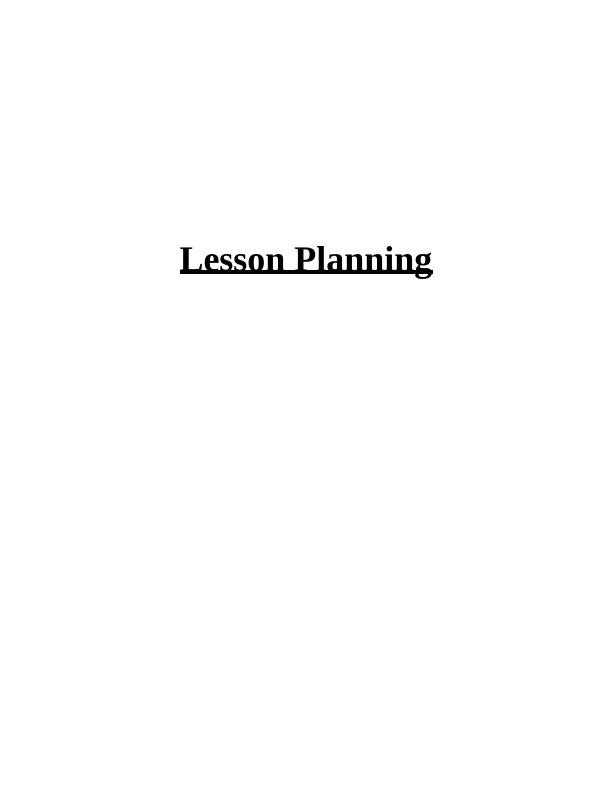
TABLE OF CONTENTS
INTRODUCTION...........................................................................................................................3
TASK 1 ...........................................................................................................................................3
1.1 Explaining the aim of lesson planning..................................................................................3
1.2 Describing the characteristics of an effective lesson plan ...................................................3
1.3 Describing how to design lesson plans that incorporate the goals and needs of learners.....4
2.1 Analysing learning styles and learning taxonomies to be included when planning a lesson5
2.2 Explain how lesson plans incorporate learning styles and taxonomies................................7
2.3 Explain how to ensure lesson plans are inclusive.................................................................7
3.1 Explain how to prepare an effective lesson plan...................................................................7
3.2 Analyse the need for flexibility and adaptability in the design of lesson plans....................8
3.3 Explain how lesson plan design affects the delivery of inclusive teaching and learning.....8
TASK 2 LESSON PLAN................................................................................................................9
4 ..................................................................................................................................................9
TASK 3 .........................................................................................................................................14
5.1 Define..................................................................................................................................14
Assessment- .............................................................................................................................14
Evaluation.................................................................................................................................14
5.2 Analysing the use of different methods of assessment and evaluation...............................15
5.3 Explaining the use of differentiated assessment to incorporate the individual needs of
learners......................................................................................................................................17
5.4 Explain how analysis of assessment and evaluation results can be used to inform lesson
planning.....................................................................................................................................17
CONCLUSION..............................................................................................................................19
REFERENCES..............................................................................................................................20
INTRODUCTION...........................................................................................................................3
TASK 1 ...........................................................................................................................................3
1.1 Explaining the aim of lesson planning..................................................................................3
1.2 Describing the characteristics of an effective lesson plan ...................................................3
1.3 Describing how to design lesson plans that incorporate the goals and needs of learners.....4
2.1 Analysing learning styles and learning taxonomies to be included when planning a lesson5
2.2 Explain how lesson plans incorporate learning styles and taxonomies................................7
2.3 Explain how to ensure lesson plans are inclusive.................................................................7
3.1 Explain how to prepare an effective lesson plan...................................................................7
3.2 Analyse the need for flexibility and adaptability in the design of lesson plans....................8
3.3 Explain how lesson plan design affects the delivery of inclusive teaching and learning.....8
TASK 2 LESSON PLAN................................................................................................................9
4 ..................................................................................................................................................9
TASK 3 .........................................................................................................................................14
5.1 Define..................................................................................................................................14
Assessment- .............................................................................................................................14
Evaluation.................................................................................................................................14
5.2 Analysing the use of different methods of assessment and evaluation...............................15
5.3 Explaining the use of differentiated assessment to incorporate the individual needs of
learners......................................................................................................................................17
5.4 Explain how analysis of assessment and evaluation results can be used to inform lesson
planning.....................................................................................................................................17
CONCLUSION..............................................................................................................................19
REFERENCES..............................................................................................................................20
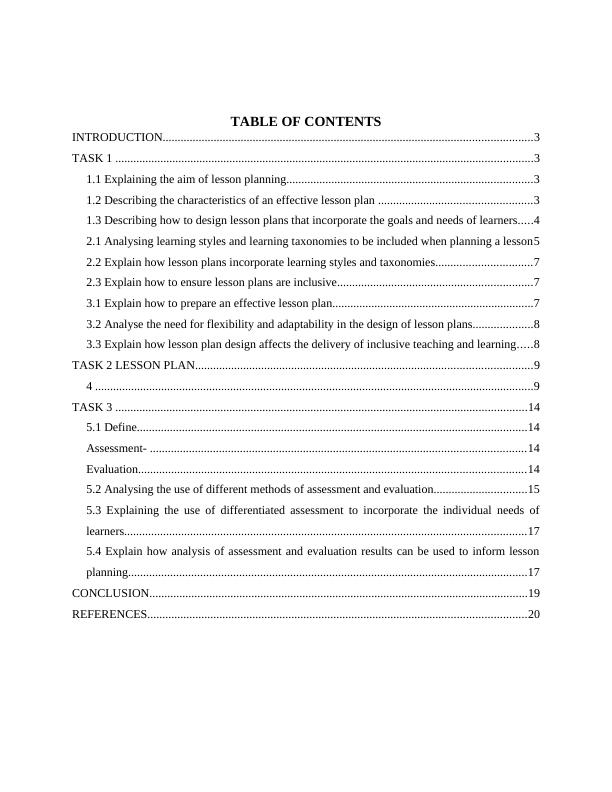
INTRODUCTION
Lesson planning is the process or activity performed by teachers or leaders before the
actual lesson takes place in the classroom. In other words, it is a detailed information of the
instructional learning activities and strategies which needs to be performed during the process of
teaching and training.
The present report will be based on lesson planning which is essential step before the
class so that students can learn effectively. Furthermore, the study will also provide detailed
information about aim, characteristics and learning styles. In addition to this, it will analyse
different methods and theory of assessment and evaluation in order to inform lesson planning. To
meet the individual needs of learners or students the teacher follow various strategies and
methods.
TASK 1
1.1 Explaining the aim of lesson planning
A lesson planning plays a vital role for the teachers as it is a road map used by them to
find out need of students for learning process. It also highlights how it will be done effectively to
motivate them during the time of class. In addition to this, it is a detailed description of the
learning activities which need to be performed while managing the teaching procedure.
Nowadays, during the class time, teachers provide detailed information and strategies to students
in order to guide them. The major purpose and aim of lesson plan is to determine what the
learners will learn in the classroom, how the overall subject will be taught as well as how
teaching will be done and how learning of students will be evaluated. According to McConnell,
Conrad and Uhrmacher, (2020), major aim of lesson planning is to evaluate whether learners
able to understand what teachers are explaining them. By the end of lesson, the teachers provide
feedback to students for their assessment and describe what they have learned during the session.
1.2 Describing the characteristics of an effective lesson plan
By making effective lesson planning, the teachers will be able to clearly outline the needs
of learners to learn things.
An effective lesson plan allow students to feel a sense of shared ideas, knowledge and
discovery of new things. They can feel a sense of shared exploration which is beneficial
for them to achieve success. Moreover, It includes process of evaluation and end
Lesson planning is the process or activity performed by teachers or leaders before the
actual lesson takes place in the classroom. In other words, it is a detailed information of the
instructional learning activities and strategies which needs to be performed during the process of
teaching and training.
The present report will be based on lesson planning which is essential step before the
class so that students can learn effectively. Furthermore, the study will also provide detailed
information about aim, characteristics and learning styles. In addition to this, it will analyse
different methods and theory of assessment and evaluation in order to inform lesson planning. To
meet the individual needs of learners or students the teacher follow various strategies and
methods.
TASK 1
1.1 Explaining the aim of lesson planning
A lesson planning plays a vital role for the teachers as it is a road map used by them to
find out need of students for learning process. It also highlights how it will be done effectively to
motivate them during the time of class. In addition to this, it is a detailed description of the
learning activities which need to be performed while managing the teaching procedure.
Nowadays, during the class time, teachers provide detailed information and strategies to students
in order to guide them. The major purpose and aim of lesson plan is to determine what the
learners will learn in the classroom, how the overall subject will be taught as well as how
teaching will be done and how learning of students will be evaluated. According to McConnell,
Conrad and Uhrmacher, (2020), major aim of lesson planning is to evaluate whether learners
able to understand what teachers are explaining them. By the end of lesson, the teachers provide
feedback to students for their assessment and describe what they have learned during the session.
1.2 Describing the characteristics of an effective lesson plan
By making effective lesson planning, the teachers will be able to clearly outline the needs
of learners to learn things.
An effective lesson plan allow students to feel a sense of shared ideas, knowledge and
discovery of new things. They can feel a sense of shared exploration which is beneficial
for them to achieve success. Moreover, It includes process of evaluation and end
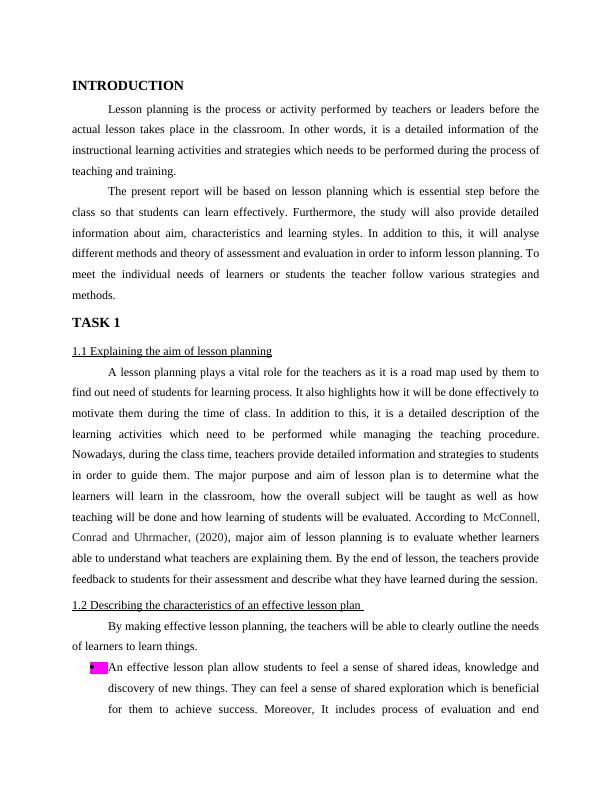
assignment. In general, it should be relatable and detailed to teaching techniques and
must be clearly defined. The teachers can provide review on content from the previous
information about lesson. It is essential to mention timing, subject and age of students in
the lesson planning.
An effective lesson plan plays a vital role to engage both students and teachers as it
provide clear instructions, improve self assessment and guide detailed explanations. With
the help of great lesson plan and motivational techniques, the teacher can effectively
guide their students in class (Janssen, Knoef and Lazonder, 2019). By using necessary
materials students can complete their assessment on time as this lesson planning is based
on past knowledge and experience. Along with this, it is essential to include important
aspects and examples related to each subject so that students can understand the major
concepts.
1.3 Describing how to design lesson plans that incorporate the goals and needs of learners
According to (Hatch and Clark, 2021), there are different types of theories and opinions
about lesson plan, it is necessary to use effective lesson plan in a most innovative way. This
contains various components like-
Mention clear and effective objectives that teachers want learners to learn.
After that it is important to include an introduction about the lesson plan so that student
can easily understand the overall detail.
The engagement of learners in learning activities designed by teachers to help them learn
the important content or knowledge which is beneficial for them to improve skills.
If lesson plans are designed in a most innovative way, it is an opportunity for learners to
practice (Nagro, Fraser and Hooks, 2019). By providing feedback to students on their
individual performance teachers can help them to improve skills and increase progress
level.
A conclusion or summary to the lesson plays a vital role so that they can understand the
overall study. By doing so, the students will be able to increase their knowledge level and
understanding about teaching practice done in the class.
Lastly, assessment is important for students in order to find out what they have learned
during the class.
must be clearly defined. The teachers can provide review on content from the previous
information about lesson. It is essential to mention timing, subject and age of students in
the lesson planning.
An effective lesson plan plays a vital role to engage both students and teachers as it
provide clear instructions, improve self assessment and guide detailed explanations. With
the help of great lesson plan and motivational techniques, the teacher can effectively
guide their students in class (Janssen, Knoef and Lazonder, 2019). By using necessary
materials students can complete their assessment on time as this lesson planning is based
on past knowledge and experience. Along with this, it is essential to include important
aspects and examples related to each subject so that students can understand the major
concepts.
1.3 Describing how to design lesson plans that incorporate the goals and needs of learners
According to (Hatch and Clark, 2021), there are different types of theories and opinions
about lesson plan, it is necessary to use effective lesson plan in a most innovative way. This
contains various components like-
Mention clear and effective objectives that teachers want learners to learn.
After that it is important to include an introduction about the lesson plan so that student
can easily understand the overall detail.
The engagement of learners in learning activities designed by teachers to help them learn
the important content or knowledge which is beneficial for them to improve skills.
If lesson plans are designed in a most innovative way, it is an opportunity for learners to
practice (Nagro, Fraser and Hooks, 2019). By providing feedback to students on their
individual performance teachers can help them to improve skills and increase progress
level.
A conclusion or summary to the lesson plays a vital role so that they can understand the
overall study. By doing so, the students will be able to increase their knowledge level and
understanding about teaching practice done in the class.
Lastly, assessment is important for students in order to find out what they have learned
during the class.
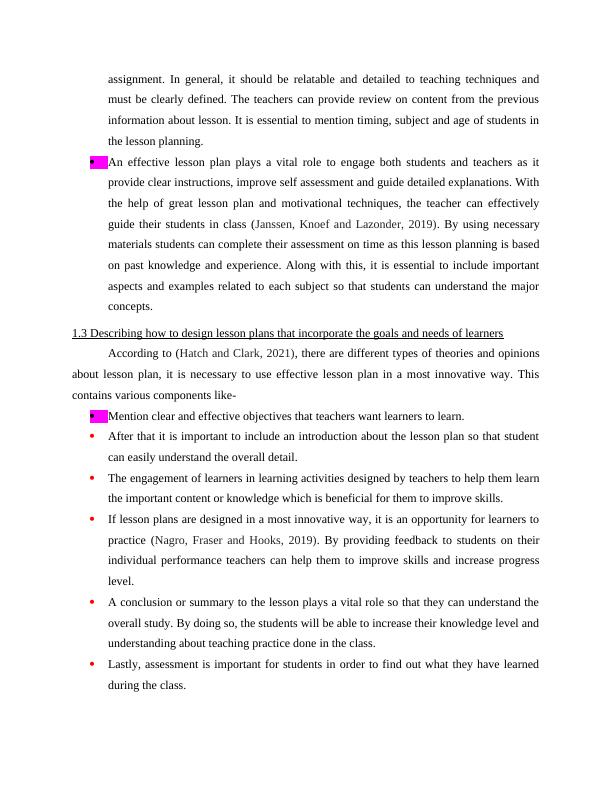
2.1 Analysing learning styles and learning taxonomies to be included when planning a lesson
Source: (learning styles, 2022)
Learning styles is used to explain about learning activities of students how they have
learned about subject taught in classroom. Learning styles plays a vital role for both students,
parents and teachers, as nowadays students are struggling to learn things immediately, and they
might need someone to teach them. They need coursework uniquely presented to them in order
to complete task on time effectively and absorb all the related materials. By evaluating this
learning styles, teachers can identify which one will be best suited for students. By adopting
effective styles of learning, students can make improvement in their studies and achieve
successful career.
Visual-
This types of learning style is used by learners when they want to retain information
which has been presented to them in different ways like graphic depiction which includes-
symbols, charts, shapes, diagrams, arrows and many more. With the help of these styles, students
can easily get clear picture of important information.
Source: (learning styles, 2022)
Learning styles is used to explain about learning activities of students how they have
learned about subject taught in classroom. Learning styles plays a vital role for both students,
parents and teachers, as nowadays students are struggling to learn things immediately, and they
might need someone to teach them. They need coursework uniquely presented to them in order
to complete task on time effectively and absorb all the related materials. By evaluating this
learning styles, teachers can identify which one will be best suited for students. By adopting
effective styles of learning, students can make improvement in their studies and achieve
successful career.
Visual-
This types of learning style is used by learners when they want to retain information
which has been presented to them in different ways like graphic depiction which includes-
symbols, charts, shapes, diagrams, arrows and many more. With the help of these styles, students
can easily get clear picture of important information.
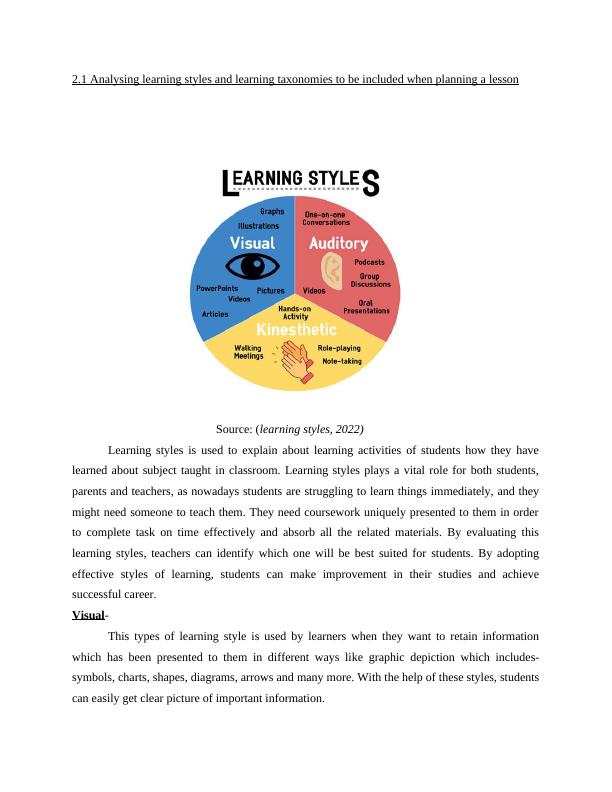
Auditory-
Auditory learning style is used by learners when they want understand important
information that is presented vocally (Wu and Yezierski, 2022). Nowadays, students prefer to
listen and use oral presentation to understand topics. These type of learners work well in team
and also in group setting in which vocal collaboration is present, and they enjoy reading things.
Writing and reading-
By adopting this style of learning, students will be able to succeed with written
information on presentation, work assignments, sheets and text heavy resources. This type of
students are note takers, and they perform effectively to achieve their task goals.
Kinesthetic-
This type of students tend to work effectively in scientific studies because of hands on lab
component or activity related to it of the coursework in the class, It includes role-playing and
note taking.
Learning Taxonomies-
Source: (Frijuniarsi and Hapsari, 2022)
Bloom's taxonomy is basically used by teachers in the classroom as its major purpose is
to give a common language to talk about assessment and curriculum designing. In other words, it
is known as hierarchy of learning objectives so that students can understand the six levels of
learning. Knowledge recalls the structure, comprehension shows what is being communicated to
Auditory learning style is used by learners when they want understand important
information that is presented vocally (Wu and Yezierski, 2022). Nowadays, students prefer to
listen and use oral presentation to understand topics. These type of learners work well in team
and also in group setting in which vocal collaboration is present, and they enjoy reading things.
Writing and reading-
By adopting this style of learning, students will be able to succeed with written
information on presentation, work assignments, sheets and text heavy resources. This type of
students are note takers, and they perform effectively to achieve their task goals.
Kinesthetic-
This type of students tend to work effectively in scientific studies because of hands on lab
component or activity related to it of the coursework in the class, It includes role-playing and
note taking.
Learning Taxonomies-
Source: (Frijuniarsi and Hapsari, 2022)
Bloom's taxonomy is basically used by teachers in the classroom as its major purpose is
to give a common language to talk about assessment and curriculum designing. In other words, it
is known as hierarchy of learning objectives so that students can understand the six levels of
learning. Knowledge recalls the structure, comprehension shows what is being communicated to
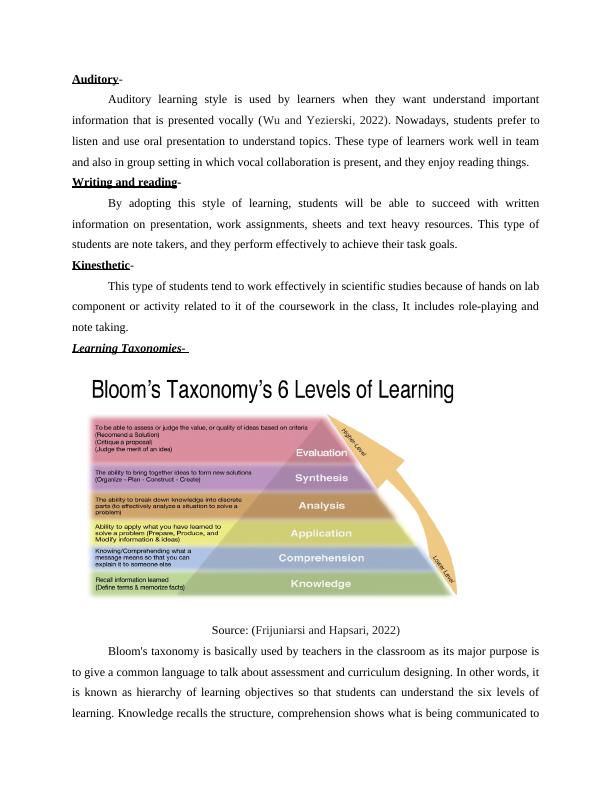
End of preview
Want to access all the pages? Upload your documents or become a member.
Related Documents
Lesson Planning: Designing Effective Lesson Plans for Inclusive Learninglg...
|18
|5198
|207
Lesson Planning for Effective Teaching and Learninglg...
|17
|5193
|399
Importance and Ways of Lesson Planning for Inclusive Teaching and Learninglg...
|18
|5570
|61
Lesson Planning: Characteristics, Design, Inclusivity, and Feedbacklg...
|15
|4456
|461
Lesson Planning: Purpose, Characteristics, Design, Learning Styles, Inclusivity, and Assessmentlg...
|18
|5411
|323
Lesson Planning: Designing Effective Lesson Plans for Inclusive Teaching and Learninglg...
|17
|5293
|337
